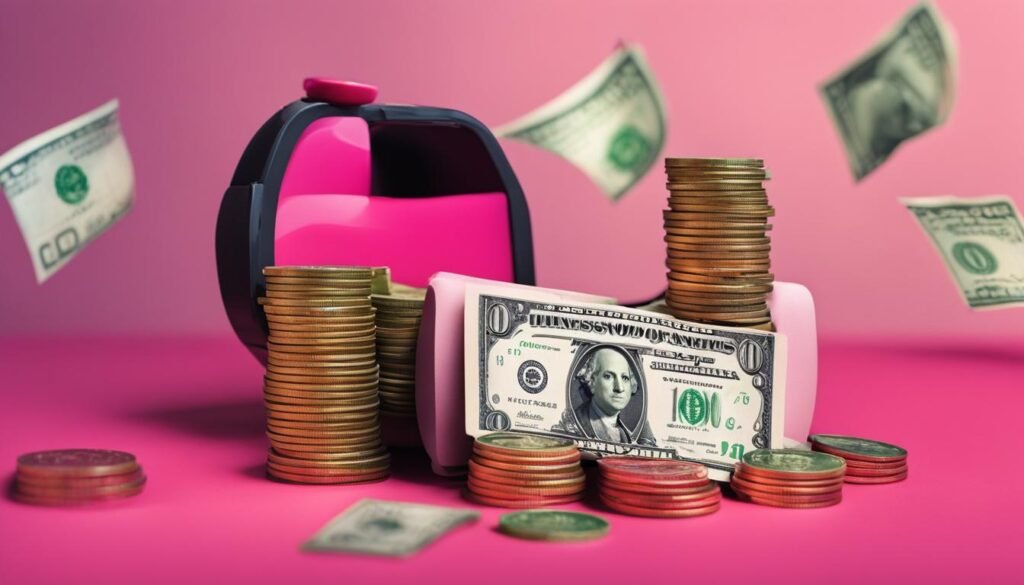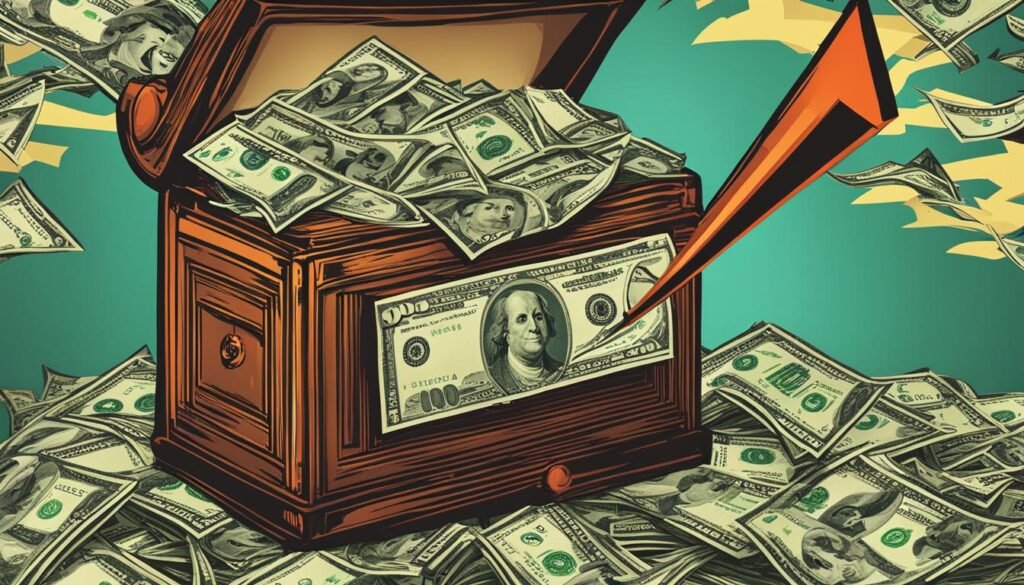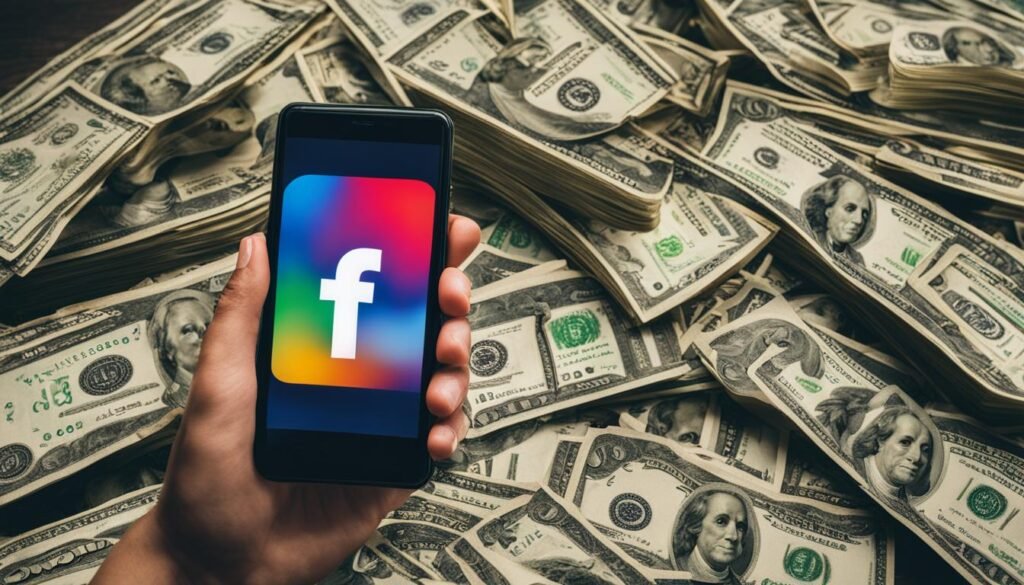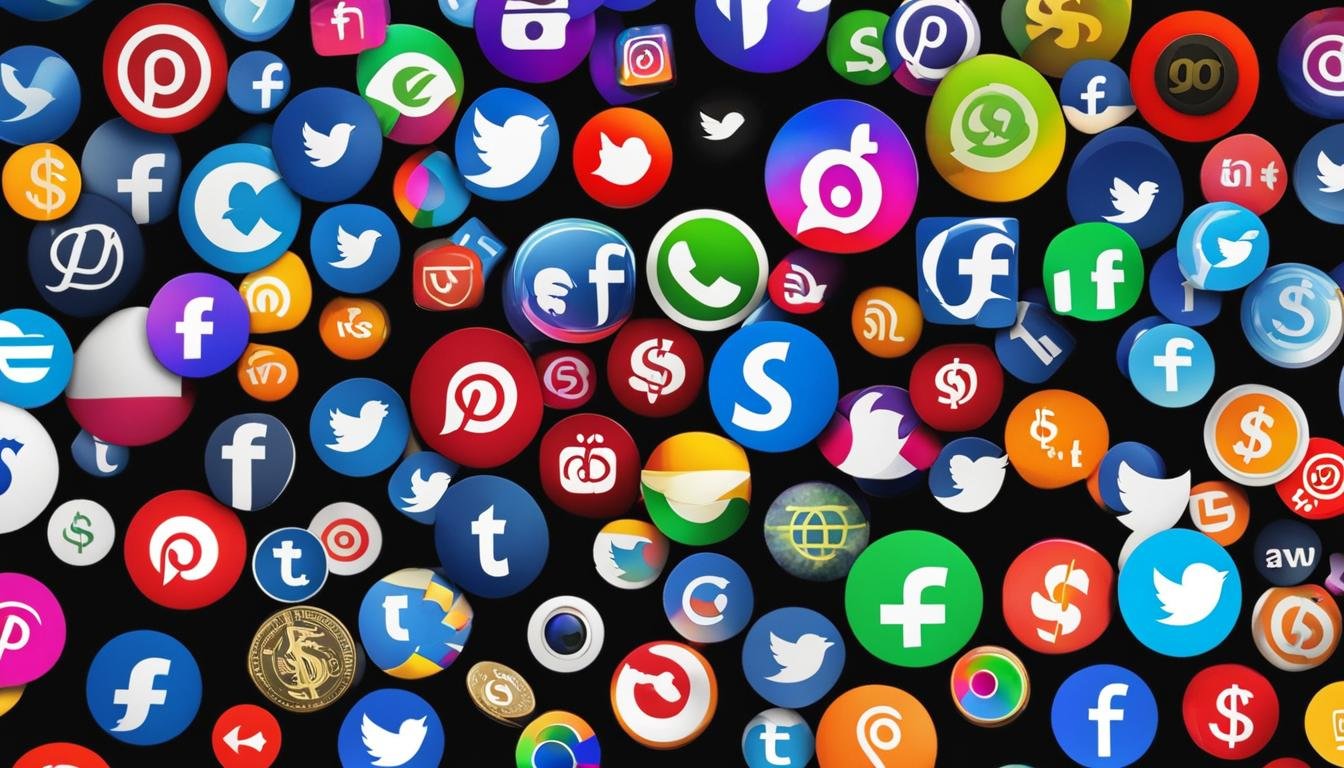Are you a content creator looking to earn money through social media? If so, you’ve come to the right place. In this article, we’ll explore the different social media platforms and their earning potential for content creators. Whether you’re a seasoned influencer or just starting out, understanding which platform pays the most can help you maximize your earnings and achieve financial success.
One of the key factors in earning money as a content creator is monetization. Each social media platform offers various ways for creators to monetize their content, such as ad revenue, brand partnerships, and sponsorships. By understanding the earning potential of different platforms, you can strategically choose the ones that align with your goals and audience.
So, which social media platform pays the most to content creators? Let’s explore the data and find out!
Key Takeaways:
- TikTok is currently the top social media platform for generating income for content creators.
- YouTube follows closely behind in terms of earning potential.
- Facebook, Twitter, and Instagram have lower earnings for creators.
- The earning potential varies depending on factors such as user engagement, monetization options, and the type of content being created.
- By strategically choosing the right platform and utilizing available monetization strategies, content creators can maximize their earnings and achieve financial success.
Which Social Media Platform Generates the Most Money?
https://www.youtube.com/watch?v=55T6JRUO59E
When it comes to revenue generation, Facebook and Instagram reign supreme among social media platforms. They are followed closely by YouTube, LinkedIn, TikTok, and Snapchat. However, it is important to note that while these platforms generate substantial revenue overall, it doesn’t necessarily translate into higher earnings for content creators.
The distribution of revenue among creators varies greatly, and certain platforms offer better earning opportunities than others. TikTok and YouTube, in particular, have emerged as top contenders for content creators looking to monetize their channels and maximize their earnings. On the other hand, Facebook and Instagram may not be as lucrative in terms of earning potential for creators.
These findings highlight the importance of carefully considering which social media platform to focus on when aiming to generate significant income. While Facebook and Instagram may generate the most money overall, TikTok and YouTube provide better earning opportunities for content creators.
“When it comes to monetizing their content, content creators should prioritize platforms that offer better earning opportunities.”
To better understand the revenue distribution, it is essential to examine the different monetization options offered by each platform, such as ad revenue sharing, sponsorships, and branded content partnerships. Evaluating these options alongside the specific audience and content type can help content creators make informed decisions that maximize their earning potential. Ultimately, the choice of platform plays a significant role in content creators’ ability to generate income and establish a successful online presence.
| Platform | Rank |
|---|---|
| 1 | |
| 2 | |
| YouTube | 3 |
| 4 | |
| TikTok | 5 |
| Snapchat | 6 |
Which Social Media Platform Pays Creators Best?
When it comes to monetizing creators and earning income on social media platforms, TikTok and YouTube emerge as the top contenders. According to research conducted among monetizing creators, approximately 30% of respondents identified TikTok as their primary income source, closely followed by YouTube at 25.8%. In contrast, platforms such as Facebook, Twitter, and Instagram have lower percentages, indicating that they offer less lucrative earning opportunities for creators.
While Facebook and Instagram may generate the most money overall, it is important to note that TikTok and YouTube provide better earning potential for content creators. This is likely due to various factors such as algorithmic reach, engagement levels, and monetization options offered by each platform.
TikTok’s algorithm prioritizes viral content, allowing creators to gain significant visibility and potentially attract a large audience. YouTube, on the other hand, offers diverse monetization options such as ad revenue sharing, channel memberships, Super Chats, and Super Thanks, providing creators with multiple avenues to earn income.
“TikTok and YouTube stand out as the platforms that offer the best opportunities to monetize your content and generate income as a creator.”
Creators looking to monetize their content should consider leveraging the earning potential of TikTok and YouTube. These platforms provide robust support and tools to help creators maximize their earnings and reach a wider audience. While Facebook, Twitter, and Instagram still offer opportunities for monetization, they may not provide the same level of earning potential as TikTok and YouTube.
The Rise of TikTok and YouTube
TikTok’s meteoric rise as a social media giant has propelled it to the forefront of creator monetization. With its user-friendly interface, seamless video editing features, and highly engaging content, TikTok has become a hub for creators looking to transform their passion into profit. The platform’s competitive algorithm ensures that even new creators have a chance to go viral and gain a substantial following.
YouTube, on the other hand, has dominated the online video space for years and continues to be a powerhouse for content creators. With its wide reach, established monetization options, and global audience, YouTube remains a lucrative platform for creators seeking to monetize their content through ad revenue and other monetization avenues.
While TikTok and YouTube may pay creators best, it is crucial for creators to analyze their target audience, content format, and engagement levels to determine which platform aligns best with their earning goals. By understanding the unique features of each platform, creators can make informed decisions to optimize their earning potential.
Who Pays More, TikTok or Instagram?

TikTok has emerged as the platform that pays more to creators compared to Instagram. In fact, TikTok has become the primary income source for a significant number of content creators, even those earning less than $10,000 per year. According to a recent study, 28.6% of creators who earn less than $10,000 per year cite TikTok as their main income source, compared to only 7.3% for Instagram.
TikTok’s relatively new position in the market, coupled with its focus on viral content, has contributed to higher income opportunities for creators on the platform. Instagram, on the other hand, offers a more established landscape but falls behind when it comes to income potential for creators.
With TikTok’s exponential growth and user engagement, creators have found lucrative opportunities to monetize their content and generate higher incomes. The platform’s algorithm-driven content discovery and emphasis on virality have allowed creators to reach a wider audience and increase their earning potential.
On the other hand, while Instagram remains a popular platform, it may not offer the same level of income as TikTok for creators, particularly those starting out or with smaller follower bases. Instagram’s monetization options are geared more towards influencer marketing, sponsored content, and collaborations, which may not provide the same level of income as TikTok’s focus on creator-centric monetization models.
Ultimately, for content creators looking to maximize their earnings and tap into the growing space of social media monetization, TikTok offers a more promising income source compared to Instagram.
Which Social Media Platform Pays the Most for Views?

The landscape of social media earnings has evolved beyond relying solely on views as a payment determinant. Platforms have introduced alternative monetization options, including sponsorships, gifts, and subscription models. As a result, pinpointing the social media platform that pays the most for views has become increasingly challenging.
However, insights shared by monetizing creators shed light on earning potentials across popular platforms. TikTok’s Creator Fund, for instance, offers creators between 2 and 4 cents for every 1,000 views. Meanwhile, on YouTube, creators can earn approximately $18 per 1,000 ad views. It is important to note that Facebook’s payment structure for views is more nuanced and not as straightforward.
With the evolution of social media monetization models, it is crucial for content creators to diversify their revenue streams beyond views. Engaging with other payment options such as sponsorships, gifts, and subscriptions can significantly impact earning potential. It’s important for creators to explore and leverage the various monetization strategies provided by platforms.
Earnings per 1,000 Views on Select Social Media Platforms
| Social Media Platform | Earnings per 1,000 Views |
|---|---|
| TikTok (via Creator Fund) | Between 2 and 4 cents |
| YouTube (ad views) | Around $18 |
| Facebook (views) | Varies |
This table presents the approximate earnings per 1,000 views on select social media platforms. While TikTok’s Creator Fund offers a specific range, YouTube provides a fixed earning per 1,000 ad views. Facebook’s payment structure for views is more dynamic and subject to variation.
Overall, it’s important to approach social media earnings holistically rather than solely relying on views. Creators should diversify their monetization strategies and explore other avenues such as sponsorships, gifts, and subscriptions to maximize their earning potential.
Which Social Media Platform Pays the Most in 2024?

When it comes to determining which social media platform will pay the most in 2024, there are several factors to consider. The type of content being created and the engagement level of the creator play significant roles in determining earnings. While we cannot provide a definitive answer, based on current data, certain platforms emerge as frontrunners.
TikTok ranks at the top as the top platform for generating income for content creators. Known for its short-form video content, TikTok has gained massive popularity and offers significant earning potential. Creators are able to leverage the platform’s wide reach and engage with a large audience, increasing their chances of monetization.
Following closely behind TikTok, YouTube holds its position as a top earning platform for creators. With its established monetization options such as ad revenue sharing, channel memberships, and Super Chats, YouTube offers a range of opportunities to earn from content.
Although Facebook, Twitter, and Instagram have their share of creators, their earnings tend to be lower compared to TikTok and YouTube. However, these platforms should not be disregarded, as their broad user bases and advertising options still provide potential for content monetization.
To choose the best platform for maximizing earnings in 2024, creators need to take into account their target audience, content format, and available monetization options. Understanding these factors will help creators make informed decisions about which platform aligns best with their goals and earning potential.
| Social Media Platform | Earning Potential |
|---|---|
| TikTok | High |
| YouTube | Medium |
| Low | |
| Low | |
| Low |
Monetization Options on Social Media Platforms

Different social media platforms offer various paths to monetization for content creators. Understanding the monetization options available on each platform is essential for content creators to maximize their earnings.
TikTok
TikTok provides multiple avenues for creators to earn money:
- TikTok Creator Fund: Creators can join the TikTok Creator Fund and earn money based on the engagement and performance of their content.
- Sponsorships: Creators can collaborate with brands and receive payments for promoting their products or services.
- Gifts: TikTok allows viewers to send virtual gifts to their favorite creators, and creators can convert those gifts into real money.
- Branded Content Partnerships: Creators can form partnerships with brands to develop sponsored content campaigns.
YouTube
YouTube offers several monetization options for content creators:
- Ad Revenue Sharing: Creators can monetize their videos through advertisements and share the revenue generated from those ads.
- Channel Memberships: Creators can offer exclusive perks to their channel members in exchange for a monthly fee.
- Super Chats and Super Thanks: Creators can receive monetary tips from viewers during live chats and premieres.
Instagram allows content creators to monetize their profiles through various means:
- Ads: Creators can participate in the Instagram Partner Program and earn money from ads displayed on their content.
- Affiliates: Creators can partner with companies and earn commissions for promoting their products or services.
- Branded Content: Creators can collaborate with brands to create sponsored posts and receive compensation.
- Subscriptions: Creators can offer exclusive content to their subscribers in exchange for a recurring fee.
Facebook offers several options for content creators to monetize their presence:
- In-Stream Ads: Creators can earn money from advertisements displayed in their videos.
- Reels Ads: Creators can monetize their short-form videos with ads.
- Branded Content: Creators can collaborate with brands to create sponsored posts and videos.
- Subscriptions: Creators can offer exclusive content to subscribers for a monthly fee.
These are just a few examples of the monetization options available on popular social media platforms. Content creators should explore their options and choose the platforms and strategies that best align with their content, audience, and earning goals.
| Social Media Platform | Monetization Options |
|---|---|
| TikTok | TikTok Creator Fund, Sponsorships, Gifts, Branded Content Partnerships |
| YouTube | Ad Revenue Sharing, Channel Memberships, Super Chats, Super Thanks |
| Ads, Affiliates, Branded Content, Subscriptions | |
| In-Stream Ads, Reels Ads, Branded Content, Subscriptions |
Tips for Maximizing Earnings on Social Media Platforms

To maximize earnings on social media platforms, content creators need to focus on creating engaging content that resonates with their target audience. By producing high-quality and valuable content, creators can attract and retain a loyal following, increasing their monetization opportunities.
One effective strategy for maximizing earnings is to explore opportunities for sponsored posts and collaborations with brands that align with the creator’s niche. By partnering with relevant brands, creators can not only earn money but also strengthen their credibility and reach a wider audience.
Building a strong following is crucial for maximizing earnings on social media platforms. Creators should actively engage with their audience by responding to comments, initiating conversations, and implementing interactive elements such as polls or Q&A sessions. This helps foster a sense of community and encourages audience loyalty, which can open doors to additional monetization opportunities like brand partnerships and influencer marketing campaigns.
Social media platforms provide various monetization strategies that creators can leverage to maximize their earnings. By taking advantage of features like ad revenue sharing, subscriptions, and branded content partnerships, creators can diversify their income streams and increase their overall earnings.
Engaging content is the key to maximizing earnings on social media platforms. By creating content that captures the attention and interest of the audience, creators can drive more traffic, engagement, and monetization opportunities.
Key Tips for Maximizing Earnings on Social Media Platforms:
- Create engaging and valuable content that resonates with your target audience.
- Explore opportunities for sponsored posts and collaborations with relevant brands.
- Build a strong following by actively engaging with your audience.
- Utilize the available monetization strategies provided by the platforms.
By implementing these tips and continuously adapting to the evolving landscape of social media, content creators can maximize their earnings and turn their passion into a profitable endeavor.
Avoiding Roadblocks in Monetization

When it comes to monetizing their content, content creators must navigate potential roadblocks that could hinder their earning potential. One major obstacle is the risk of copyright claims, which can arise from using copyrighted material without proper authorization.
Copyright claims can result in content being taken down or demonetized, negatively impacting a creator’s ability to earn money from their work. To avoid copyright issues and ensure a smooth monetization process, creators should be cautious when incorporating copyrighted material into their content.
Using royalty-free music is an effective way to avoid copyright roadblocks in content monetization. By utilizing royalty-free music, creators can enhance the production value of their content without the risk of copyright violations.
Epidemic Sound offers creators access to a vast catalog of royalty-free music that can be used in their videos, podcasts, and other multimedia content. This eliminates the need to obtain individual licenses for copyrighted music and allows creators to focus on creating engaging content without worrying about potential copyright claims.
By leveraging royalty-free music from platforms like Epidemic Sound, content creators can monetize their work more effectively while maintaining full compliance with copyright laws. This not only safeguards their earnings but also ensures a hassle-free monetization experience.
Implementing royalty-free music into content creation opens up opportunities for creators to add depth and creativity to their work while avoiding potential legal roadblocks.
Benefits of Using Royalty-Free Music for Monetization
Here are some key benefits of choosing royalty-free music:
- Legal Compliance: By using royalty-free music, creators can rest assured that they are not infringing on any copyright laws or facing potential copyright claims.
- Enhanced Production Value: Access to high-quality royalty-free music elevates the production value of content, making it more engaging and appealing to viewers.
- Creative Freedom: Royalty-free music libraries offer a diverse range of genres and styles, allowing creators to find the perfect soundtrack that enhances their content’s mood and atmosphere.
- Cost Savings: Instead of paying for individual licenses or facing expensive legal consequences, creators can access a wide range of royalty-free music through affordable subscription services.
- Peace of Mind: With royalty-free music, creators can focus on producing exceptional content without the fear of copyright claims or interrupted monetization processes.
By incorporating royalty-free music into their content, creators can maximize their earning potential while minimizing the risk of encountering roadblocks in monetization.
Next, we’ll explore other social media platforms that offer opportunities for content creators to monetize their work beyond the major platforms.
Other Social Media Platforms That Pay Creators
While major social media platforms like TikTok, YouTube, Facebook, Twitter, and Instagram provide significant opportunities for content creators to monetize their work, there are also other platforms that offer payment options. These platforms offer additional avenues for creators to expand their earning potential and reach a wider audience. Two such platforms that pay creators are Snapchat and Pinterest.
Snapchat
Snapchat, a popular multimedia messaging app, not only allows users to share photos and videos but also offers opportunities for content creators to earn money. Creators can monetize their content on Snapchat through various channels:
- Spotlight feature: Creators can submit their best video Snaps to Spotlight, where they have the chance to earn a share of the daily $1 million that Snapchat distributes to top-performing creators.
- In-stream ads: Snapchat allows creators to monetize their Stories and Shows through in-stream ads, which appear during the playback of their content and provide a source of revenue.
- Brand partnerships: Creators can collaborate with brands and promote their products through sponsored content, enabling them to earn income from these partnerships.
Pinterest, a visual discovery and bookmarking platform, offers opportunities for content creators to monetize their content through brand partnerships and shoppable pins. Here’s how creators can earn money on Pinterest:
- Brand partnerships: Pinterest allows creators to collaborate with brands and create sponsored content. Through these partnerships, creators can promote products and earn income based on their engagement and reach.
- Shoppable pins: Creators can leverage Pinterest’s shoppable pins feature to monetize their content. By adding shopping tags to their pins, they can link directly to products, making it easier for their audience to discover and purchase those items.
These platforms provide content creators with alternative options for monetizing their content, diversifying their income streams, and reaching new audiences. By exploring opportunities on Snapchat and Pinterest, creators can expand their earning potential and unlock new possibilities for content monetization.
Joining Platforms and Starting to Earn on Social Media

To start earning on social media platforms, creators can sign up and create accounts on the specific platforms they choose to monetize. By signing up, creators gain access to a wide range of features and tools that allow them to generate revenue from their content.
Creating an account is a straightforward process that typically requires providing basic personal information and agreeing to the platform’s terms and conditions. Once the account is set up, creators can begin customizing their profiles, adding profile pictures, bios, and other personal details to make their presence more engaging for their audience.
After creating an account, the next step is to connect their social media profiles securely. This integration is crucial as it allows creators to share their content seamlessly across different platforms, expanding their reach and visibility. By connecting their profiles, creators can easily cross-promote their content and attract a broader audience.
Once the accounts are set up and connected, creators can start engaging with their audience. This involves creating and sharing content regularly, responding to comments and messages, and actively participating in discussions. Building a strong relationship with the audience is key to growing a loyal following and increasing earning potential.
Each social media platform offers different monetization options, and creators can choose the ones that best suit their content and audience. These options can range from ad revenue sharing to sponsored content, branded partnerships, merchandise sales, and more. It’s essential for creators to familiarize themselves with the specific monetization options available on each platform and explore which ones align with their goals and target audience.
By actively participating and consistently creating quality content, creators can begin to earn money and build their online presence as a revenue-generating asset. It’s important to remember that success doesn’t happen overnight, and creators should be patient and persistent in their efforts to monetize their content effectively.
Also Read : Navigating Hacking In Social Media Safely
Conclusion
Social media earnings can be a lucrative source of income for content creators, with various monetization options available. Based on research, TikTok and YouTube currently offer better earning opportunities compared to Facebook, Twitter, and Instagram. To maximize earnings, creators should focus on creating engaging content that resonates with their target audience. Additionally, exploring sponsored content and branded partnerships can provide additional income streams.
Utilizing the available monetization strategies provided by the platforms is essential, including ad revenue sharing, subscriptions, and branded content partnerships. By selecting the right platforms based on their target audience and content format, creators can ensure long-term earning potential on social media.
Content monetization on social media requires a strategic approach. Creators must stay updated on platform policies, algorithm changes, and best practices to continually adapt their content strategy and maximize earnings. The social media landscape is dynamic, so it’s important for creators to stay informed and experiment with new monetization features and trends to increase their revenue streams.
FAQs
Q: What are the top social media platforms that pay influencers?
A: The top social media platforms that pay influencers include Instagram, YouTube, TikTok, and Facebook. Each of these platforms offers opportunities for influencers to monetize their content.
Q: How can I know which social media platform offers the highest earning potential?
A: You can compare the earning potential of different social media platforms by looking at factors such as active users, willingness to pay for sponsored content, and the overall culture of the platform towards supporting content creators.
Q: What types of content can be monetized on social media platforms?
A: High-quality content across various categories such as lifestyle, fashion, beauty, travel, fitness, and entertainment can be monetized on social media platforms through sponsored posts, affiliate marketing, and advertising.
Q: How can creators increase their earnings on social media platforms?
A: Creators can increase their earnings by consistently creating high-quality content, building a loyal and engaged audience, collaborating with brands, and diversifying their revenue streams through various monetization methods such as sponsored content and affiliate marketing.
Q: What are the essential factors to consider in order to monetize social media content effectively?
A: Creating engaging and authentic content, understanding the audience demographics, building a strong personal brand, and developing partnerships with brands that align with the creator’s content are essential factors for effective monetization of social media content.
Q: How can I learn which social media platform pays content creators the most?
A: You can research and compare the monetization structures, average earnings of creators, and the willingness of the platforms to pay content creators for their work to learn which social media platform pays content creators the most.
Q: Can creators earn money through sponsored posts on social media?
A: Yes, creators can earn money through sponsored posts on social media by collaborating with brands and promoting their products or services to their audience in an authentic and engaging manner.
Q: What is the significance of creating high-quality content for monetizing on social media platforms?
A: High-quality content is crucial for monetizing on social media platforms as it attracts a larger and more engaged audience, builds trust with followers, and increases the likelihood of brands being willing to pay for sponsored content or partnerships.
Q: How can influencers monetize their content and make money on social media?
A: Influencers can monetize their content and make money on social media through various methods such as sponsored posts, affiliate marketing, selling digital or physical products, and providing exclusive paid content or services to their audience.
Q: What are the highest-paying social media platforms for creators to earn money online?
A: Instagram, YouTube, and TikTok are among the highest-paying social media platforms for creators to earn money online due to their large user base and the willingness of brands to invest in influencer marketing on these platforms.
Source Links
- https://www.epidemicsound.com/blog/which-social-media-platform-pays-the-most/
- https://www.makeuseof.com/social-media-platforms-that-pay-creators/
- https://www.linkedin.com/pulse/maximize-your-earnings-get-paid-socialize-facebook-twitter-korsby-piojc?trk=article-ssr-frontend-pulse_more-articles_related-content-card





